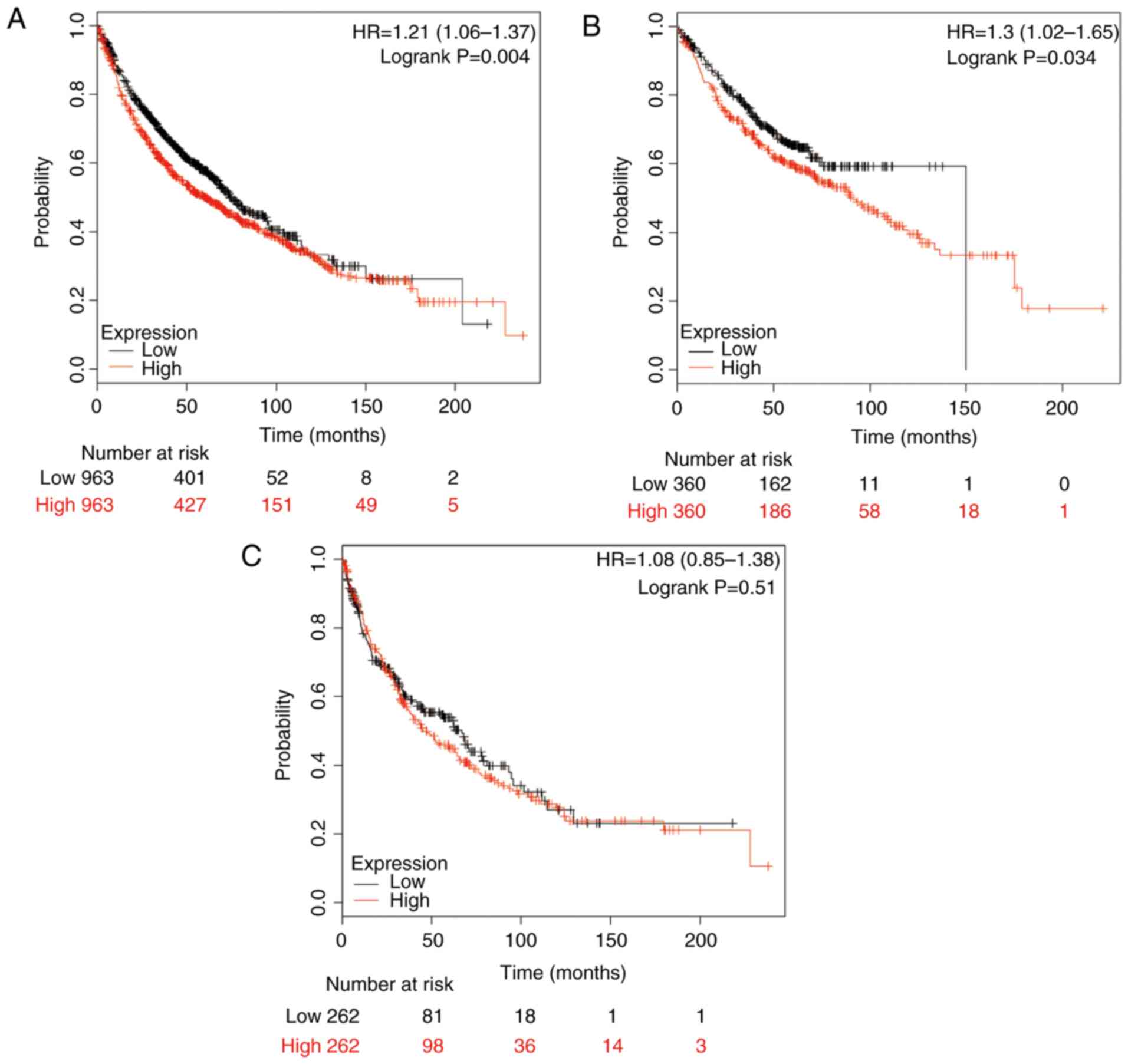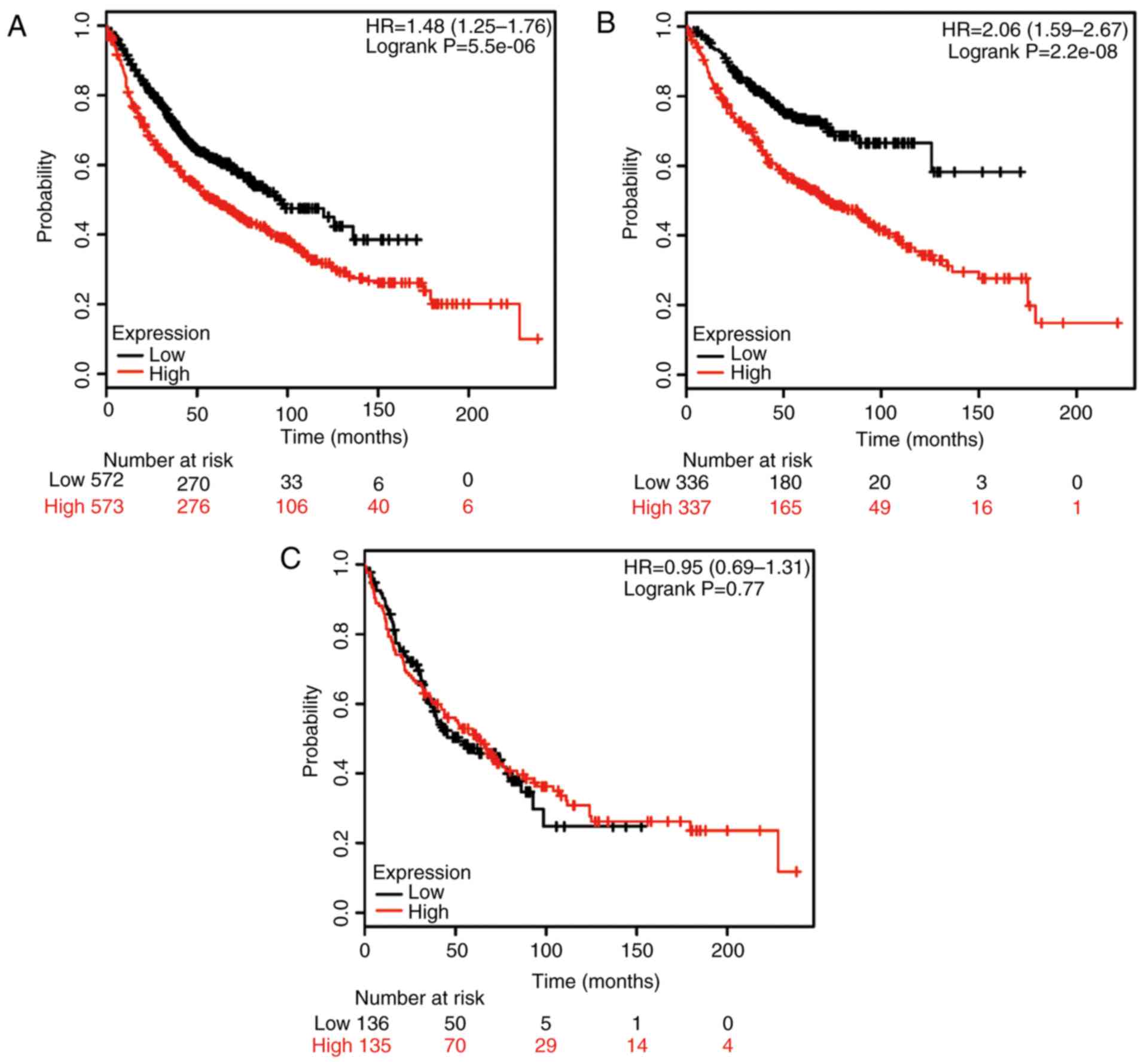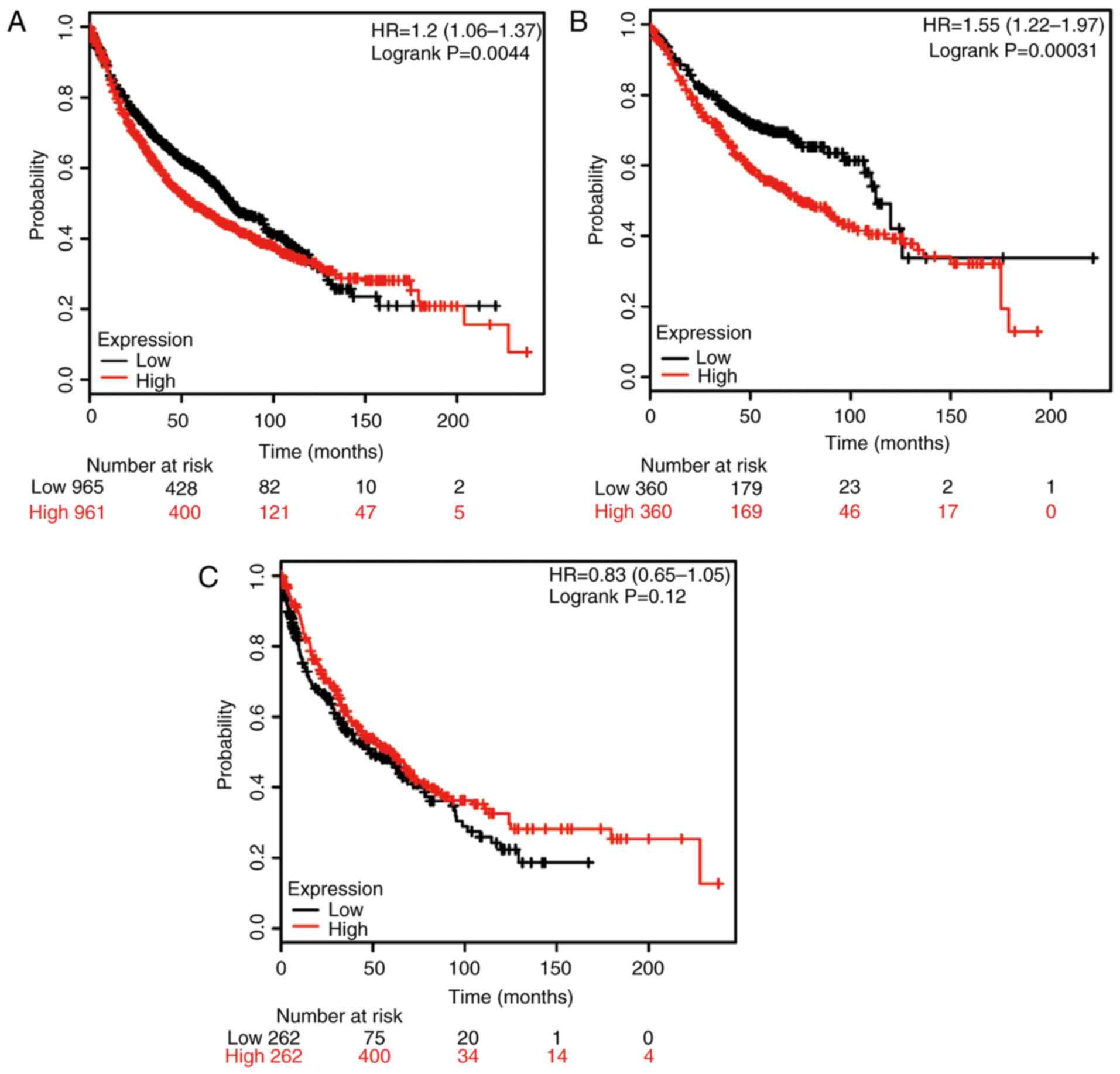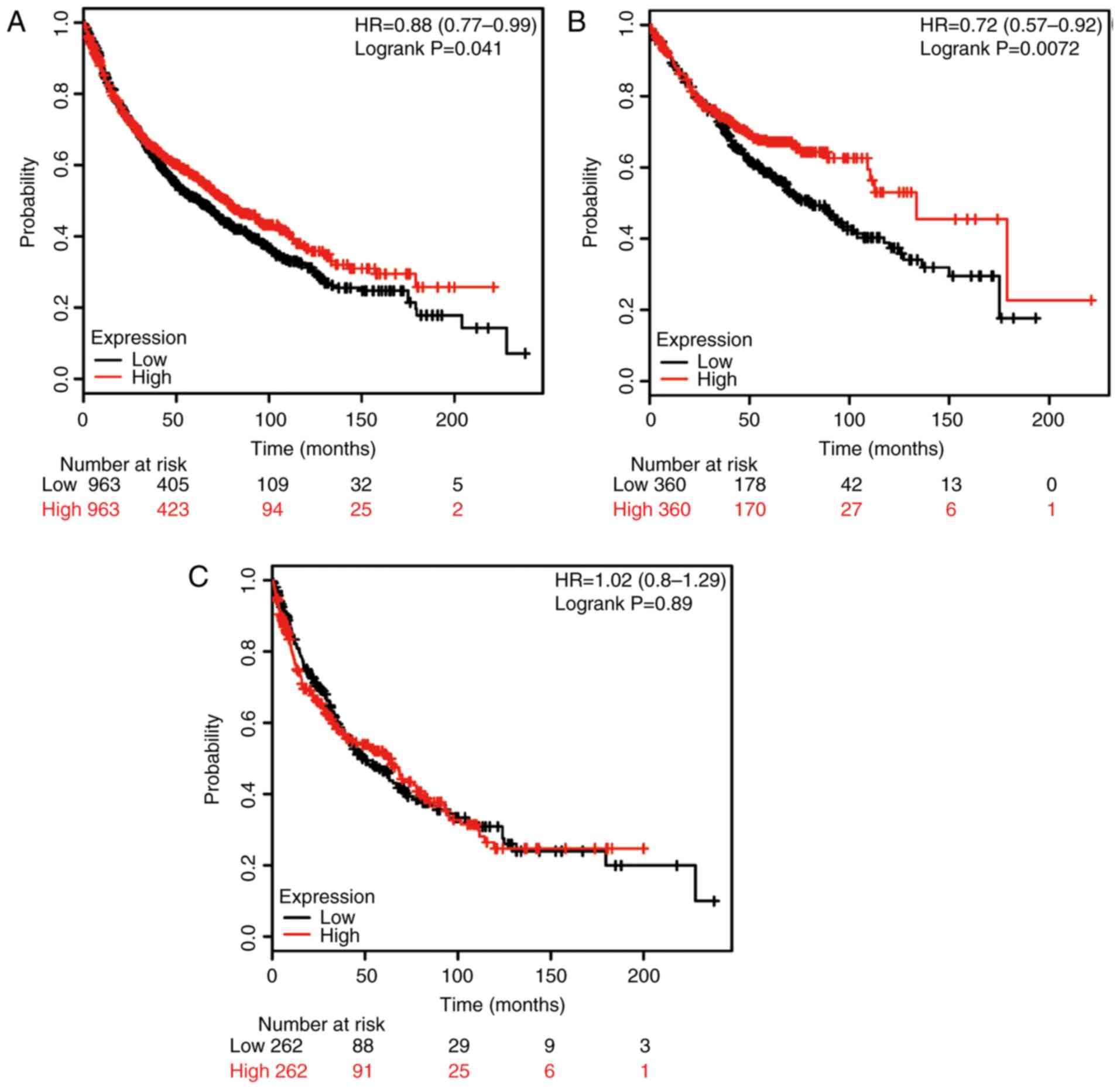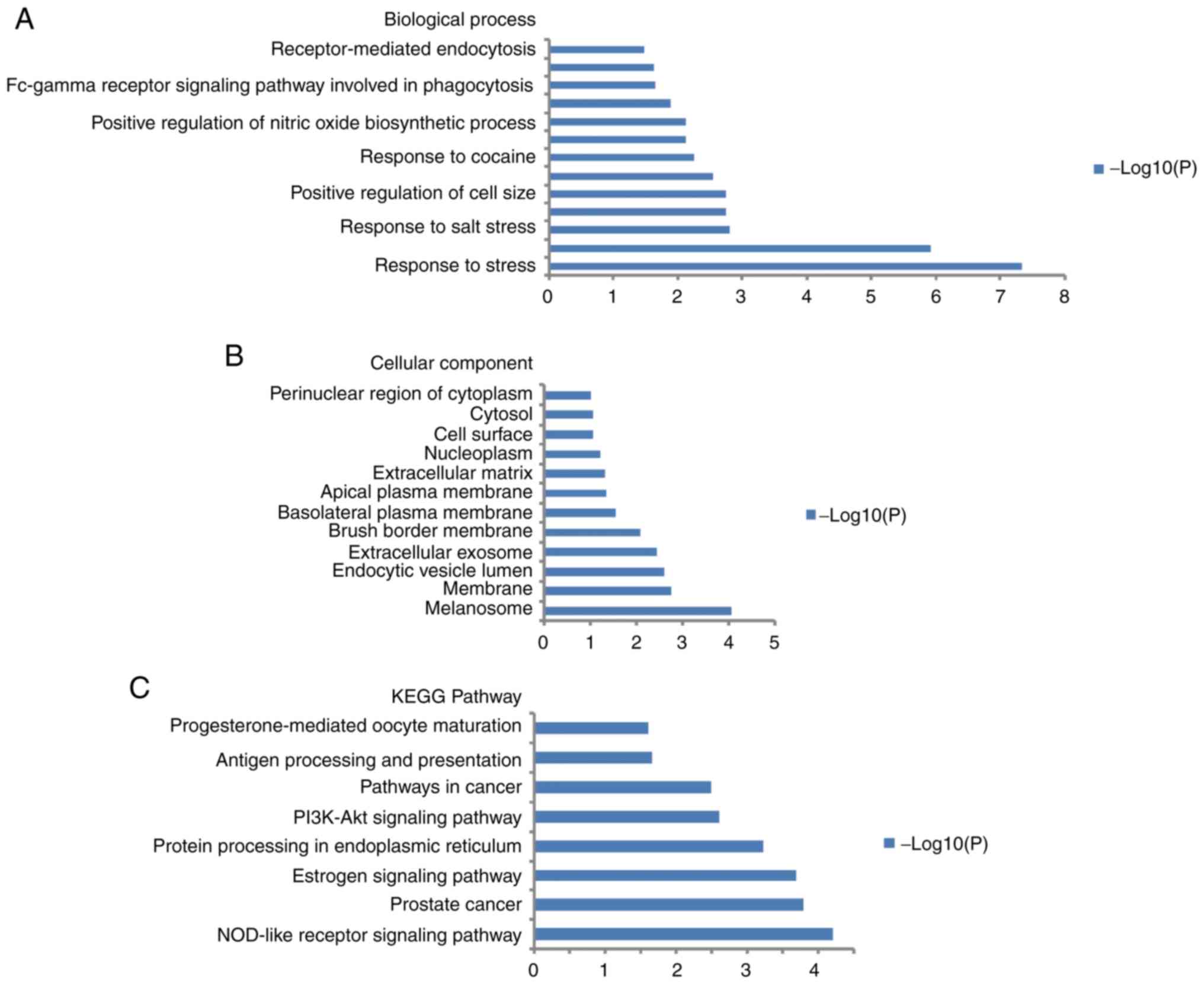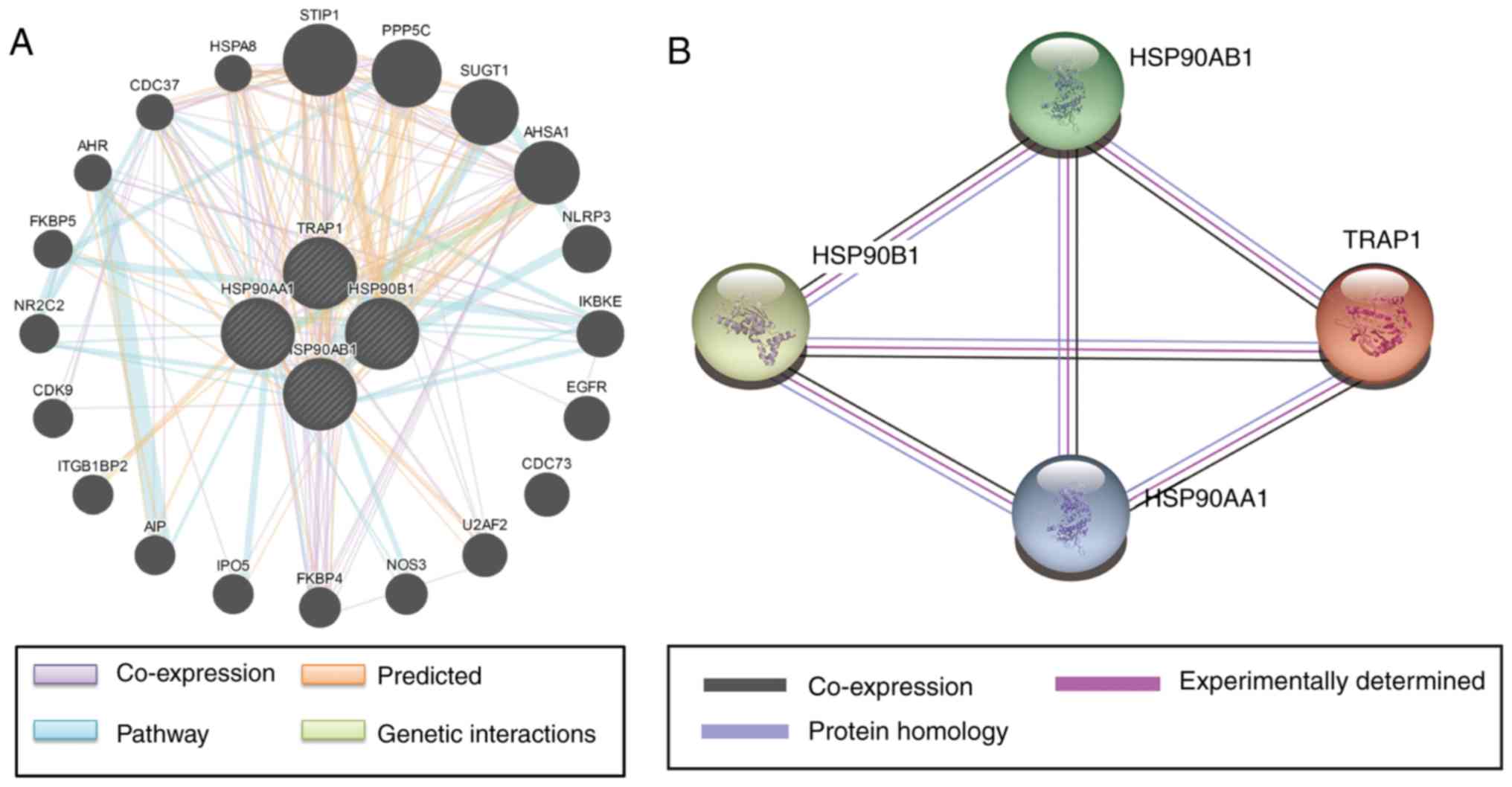|
1
|
Siegel RL, Miller KD and Jemal A: Cancer
statistics, 2016. CA Cancer J Clin. 66:7–30. 2016. View Article : Google Scholar : PubMed/NCBI
|
|
2
|
Torre LA, Bray F, Siegel RL, Ferlay J,
Lortet-Tieulent J and Jemal A: Global cancer statistics, 2012. CA
Cancer J Clin. 65:87–108. 2015. View Article : Google Scholar : PubMed/NCBI
|
|
3
|
Minna JD, Roth JA and Gazdar AF: Focus on
lung cancer. Cancer Cell. 1:49–52. 2002. View Article : Google Scholar : PubMed/NCBI
|
|
4
|
Burrows F, Zhang H and Kamal A: Hsp90
activation and cell cycle regulation. Cell Cycle. 3:1530–1536.
2004. View Article : Google Scholar : PubMed/NCBI
|
|
5
|
Kolosenko I, Grander D and Tamm KP: IL-6
activated JAK/STAT3 pathway and sensitivity to Hsp90 inhibitors in
multiple myeloma. Curr Med Chem. 21:3042–3047. 2014. View Article : Google Scholar : PubMed/NCBI
|
|
6
|
Patel K, Wen J, Magliocca K, Muller S, Liu
Y, Chen ZG, Saba N and Diaz R: Heat shock protein 90 (HSP90) is
overexpressed in p16-negative oropharyngeal squamous cell
carcinoma, and its inhibition in vitro potentiates the effects of
chemoradiation. Cancer Chemother Pharmacol. 74:1015–1022. 2014.
View Article : Google Scholar : PubMed/NCBI
|
|
7
|
Shi Y, Liu X, Lou J, Han X, Zhang L, Wang
Q, Li B, Dong M and Zhang Y: Plasma levels of heat shock protein 90
alpha associated with lung cancer development and treatment
responses. Clin Cancer Res. 20:6016–6022. 2014. View Article : Google Scholar : PubMed/NCBI
|
|
8
|
Huang T, Chen S, Han H, Li H, Huang Z,
Zhang J, Yin Q, Wang X, Ma X, Dai P, et al: Expression of
Hsp90alpha and cyclin B1 were related to prognosis of esophageal
squamous cell carcinoma and keratin pearl formation. Int J Clin Exp
Pathol. 7:1544–1552. 2014.PubMed/NCBI
|
|
9
|
Tian WL, He F, Fu X, Lin JT, Tang P, Huang
YM, Guo R and Sun L: High expression of heat shock protein 90 alpha
and its significance in human acute leukemia cells. Gene.
542:122–128. 2014. View Article : Google Scholar : PubMed/NCBI
|
|
10
|
McCarthy MM, Pick E, Kluger Y,
Gould-Rothberg B, Lazova R, Camp RL, Rimm DL and Kluger HM: HSP90
as a marker of progression in melanoma. Ann Oncol. 19:590–594.
2008. View Article : Google Scholar : PubMed/NCBI
|
|
11
|
Záčková M, Moučková D, Lopotová T,
Ondračková Z, Klamová H and Moravcová J: Hsp90-a potential
prognostic marker in CML. Blood Cells Mol Dis. 50:184–189. 2013.
View Article : Google Scholar : PubMed/NCBI
|
|
12
|
Hirakawa H, Fujisawa H, Masaoka A, Noguchi
M, Hirayama R, Takahashi M, Fujimori A and Okayasu R: The
combination of Hsp90 inhibitor 17AAG and heavy-ion irradiation
provides effective tumor control in human lung cancer cells. Cancer
Med. 4:426–436. 2015. View
Article : Google Scholar : PubMed/NCBI
|
|
13
|
Johnson ML, Yu HA, Hart EM, Weitner BB,
Rademaker AW, Patel JD, Kris MG and Riely GJ: Phase I/II study of
HSP90 inhibitor AUY922 and erlotinib for EGFR-mutant lung cancer
with acquired resistance to epidermal growth factor receptor
tyrosine kinase inhibitors. J Clin Oncol. 33:1666–1673. 2015.
View Article : Google Scholar : PubMed/NCBI
|
|
14
|
Györffy B, Lanczky A, Eklund AC, Denkert
C, Budczies J, Li Q and Szallasi Z: An online survival analysis
tool to rapidly assess the effect of 22,277 genes on breast cancer
prognosis using microarray data of 1,809 patients. Breast Cancer
Res Treat. 123:725–731. 2010. View Article : Google Scholar : PubMed/NCBI
|
|
15
|
Huang ZC, Li H, Sun ZQ, Zheng J, Zhao RK,
Chen J, Sun SG and Wu CJ: Distinct prognostic roles of HSPB1
expression in non-small cell lung cancer. Neoplasma. 65:161–166.
2018. View Article : Google Scholar : PubMed/NCBI
|
|
16
|
Schmidt LH, Brand C, Stucke-Ring J,
Schliemann C, Kessler T, Harrach S, Mohr M, Gorlich D, Marra A,
Hillejan L, et al: Potential therapeutic impact of CD13 expression
in non-small cell lung cancer. PLoS One. 12:e01771462017.
View Article : Google Scholar : PubMed/NCBI
|
|
17
|
Xie S, Shen C, Tan M, Li M, Song X and
Wang C: Systematic analysis of gene expression alterations and
clinical outcomes of adenylate cyclase-associated protein in
cancer. Oncotarget. 8:27216–27239. 2017.PubMed/NCBI
|
|
18
|
Hou GX, Liu P, Yang J and Wen S: Mining
expression and prognosis of topoisomerase isoforms in
non-small-cell lung cancer by using Oncomine and Kaplan-Meier
plotter. PLoS One. 12:e01745152017. View Article : Google Scholar : PubMed/NCBI
|
|
19
|
Győrffy B, Surowiak P, Budczies J and
Lanczky A: Online survival analysis software to assess the
prognostic value of biomarkers using transcriptomic data in
non-small-cell lung cancer. PLoS One. 8:e822412013. View Article : Google Scholar : PubMed/NCBI
|
|
20
|
Lukas RV, Gondi V, Kamson DO, Kumthekar P
and Salgia R: State-of-the-art considerations in small cell lung
cancer brain metastases. Oncotarget. 8:71223–71233. 2017.
View Article : Google Scholar : PubMed/NCBI
|
|
21
|
Calderwood SK and Neckers L: Hsp90 in
cancer: Transcriptional roles in the nucleus. Adv Cancer Res.
129:89–106. 2016. View Article : Google Scholar : PubMed/NCBI
|
|
22
|
Zhang B, Wang J, Huang Z, Wei P, Liu Y,
Hao J, Zhao L, Zhang F, Tu Y and Wei T: Aberrantly upregulated
TRAP1 is required for tumorigenesis of breast cancer. Oncotarget.
6:44495–44508. 2015. View Article : Google Scholar : PubMed/NCBI
|
|
23
|
Palmieri C, Mancini M, Benazzi C and Della
Salda L: Heat shock protein 90 is associated with hyperplasia and
neoplastic transformation of canine prostatic epithelial cells. J
Comp Pathol. 150:393–398. 2014. View Article : Google Scholar : PubMed/NCBI
|
|
24
|
Badowska-Kozakiewicz AM and Malicka E:
Immunohistochemical evaluation of expression of heat shock proteins
HSP70 and HSP90 in mammary gland neoplasms in bitches. Pol J Vet
Sci. 15:209–214. 2012. View Article : Google Scholar : PubMed/NCBI
|
|
25
|
Lee JH, Kang KW, Kim JE, Hwang SW, Park
JH, Kim SH, Ji JH, Kim TG, Nam HY, Roh MS, et al: Differential
expression of heat shock protein 90 isoforms in small cell lung
cancer. Int J Clin Exp Pathol. 8:9487–9493. 2015.PubMed/NCBI
|
|
26
|
Wong DS and Jay DG: Emerging roles of
extracellular Hsp90 in cancer. Adv Cancer Res. 129:141–163. 2016.
View Article : Google Scholar : PubMed/NCBI
|
|
27
|
Sims JD, McCready J and Jay DG:
Extracellular heat shock protein (Hsp)70 and Hsp90α assist in
matrix metalloproteinase-2 activation and breast cancer cell
migration and invasion. PLoS One. 6:e188482011. View Article : Google Scholar : PubMed/NCBI
|
|
28
|
Eustace BK, Sakurai T, Stewart JK,
Yimlamai D, Unger C, Zehetmeier C, Lain B, Torella C, Henning SW,
Beste G, et al: Functional proteomic screens reveal an essential
extracellular role for hsp90 alpha in cancer cell invasiveness. Nat
Cell Biol. 6:507–514. 2004. View
Article : Google Scholar : PubMed/NCBI
|
|
29
|
Vartholomaiou E, Madon-Simon M, Hagmann S,
Muhlebach G, Wurst W, Floss T and Picard D: Cytosolic Hsp90α and
its mitochondrial isoform Trap1 are differentially required in a
breast cancer model. Oncotarget. 8:17428–17442. 2017. View Article : Google Scholar : PubMed/NCBI
|
|
30
|
Wang X, Song X, Zhuo W, Fu Y, Shi H, Liang
Y, Tong M, Chang G and Luo Y: The regulatory mechanism of
Hsp90alpha secretion and its function in tumor malignancy. Proc
Natl Acad Sci USA. 106:21288–21293. 2009. View Article : Google Scholar : PubMed/NCBI
|
|
31
|
Wang M, Feng L, Li P, Han N, Gao Y and
Xiao T: Hsp90AB1 protein is overexpressed in non-small cell lung
cancer tissues and associated with poor prognosis in lung
adenocarcinoma patients. Zhongguo Fei Ai Za Zhi. 19:64–69. 2016.(In
Chinese). PubMed/NCBI
|
|
32
|
Morales C, Rachidi S, Hong F, Sun S,
Ouyang X, Wallace C, Zhang Y, Garret-Mayer E, Wu J, Liu B and Li Z:
Immune chaperone gp96 drives the contributions of macrophages to
inflammatory colon tumorigenesis. Cancer Res. 74:446–459. 2014.
View Article : Google Scholar : PubMed/NCBI
|
|
33
|
Meng J, Liu Y, Han J, Tan Q, Chen S, Qiao
K, Zhou H, Sun T and Yang C: Hsp90β promoted endothelial
cell-dependent tumor angiogenesis in hepatocellular carcinoma. Mol
Cancer. 16:722017. View Article : Google Scholar : PubMed/NCBI
|
|
34
|
Sunil Kumar BV, Bhardwaj R, Mahajan K,
Kashyap N, Kumar A and Verma R: The overexpression of Hsp90B1 is
associated with tumorigenesis of canine mammary glands. Mol Cell
Biochem. 440:23–31. 2018. View Article : Google Scholar : PubMed/NCBI
|
|
35
|
Rachidi S, Sun S, Wu BX, Jones E, Drake
RR, Ogretmen B, Cowart LA, Clarke CJ, Hannun YA, Chiosis G, et al:
Endoplasmic reticulum heat shock protein gp96 maintains liver
homeostasis and promotes hepatocellular carcinogenesis. J Hepatol.
62:879–888. 2015. View Article : Google Scholar : PubMed/NCBI
|
|
36
|
Yang Z, Zhuang L, Szatmary P, Wen L, Sun
H, Lu Y, Xu Q and Chen X: Upregulation of heat shock proteins
(HSPA12A, HSP90B1, HSPA4, HSPA5 and HSPA6) in tumour tissues is
associated with poor outcomes from HBV-related early-stage
hepatocellular carcinoma. Int J Med Sci. 12:256–263. 2015.
View Article : Google Scholar : PubMed/NCBI
|
|
37
|
Hou J, Li X, Li C, Sun L, Zhao Y, Zhao J
and Meng S: Plasma membrane gp96 enhances invasion and metastatic
potential of liver cancer via regulation of uPAR. Mol Oncol.
9:1312–1323. 2015. View Article : Google Scholar : PubMed/NCBI
|
|
38
|
Chen Y, Chen C, Ma C, Sun S, Zhang J and
Sun Y: Expression of heat-shock protein gp96 in gallbladder cancer
and its prognostic clinical significance. Int J Clin Exp Pathol.
8:1946–1953. 2015.PubMed/NCBI
|
|
39
|
Xu Y, Chen Z, Zhang G, Xi Y, Sun R, Wang
X, Wang W, Chai F and Li X: HSP90B1 overexpression predicts poor
prognosis in NSCLC patients. Tumour Biol. 37:14321–14328. 2016.
View Article : Google Scholar : PubMed/NCBI
|
|
40
|
Agorreta J, Hu J, Liu D, Delia D, Turley
H, Ferguson DJ, Iborra F, Pajares MJ, Larrayoz M, Zudaire I, et al:
TRAP1 regulates proliferation, mitochondrial function, and has
prognostic significance in NSCLC. Mol Cancer Res. 12:660–669. 2014.
View Article : Google Scholar : PubMed/NCBI
|
|
41
|
Sisinni L, Maddalena F, Condelli V,
Pannone G, Simeon V, Li Bergolis V, Lopes E, Piscazzi A, Matassa
DS, Mazzoccoli C, et al: TRAP1 controls cell cycle G2-M transition
through the regulation of CDK1 and MAD2 expression/ubiquitination.
J Pathol. 243:123–134. 2017. View Article : Google Scholar : PubMed/NCBI
|
|
42
|
Schaal C and Chellappan SP:
Nicotine-mediated cell proliferation and tumor progression in
smoking-related cancers. Mol Cancer Res. 12:14–23. 2014. View Article : Google Scholar : PubMed/NCBI
|
|
43
|
Cardinale A, Nastrucci C, Cesario A and
Russo P: Nicotine: Specific role in angiogenesis, proliferation and
apoptosis. Crit Rev Toxicol. 42:68–89. 2012. View Article : Google Scholar : PubMed/NCBI
|
|
44
|
Wu YP, Kita K and Suzuki N: Involvement of
human heat shock protein 90 alpha in nicotine-induced apoptosis.
Int J Cancer. 100:37–42. 2002. View Article : Google Scholar : PubMed/NCBI
|
|
45
|
Siegelin MD: Inhibition of the
mitochondrial Hsp90 chaperone network: A novel, efficient treatment
strategy for cancer? Cancer Lett. 333:133–146. 2013. View Article : Google Scholar : PubMed/NCBI
|
|
46
|
Singh A, Singh A, Sand JM, Bauer SJ,
Hafeez BB, Meske L and Verma AK: Topically applied Hsp90 inhibitor
17AAG inhibits UVR-induced cutaneous squamous cell carcinomas. J
Invest Dermatol. 135:1098–1107. 2015. View Article : Google Scholar : PubMed/NCBI
|



